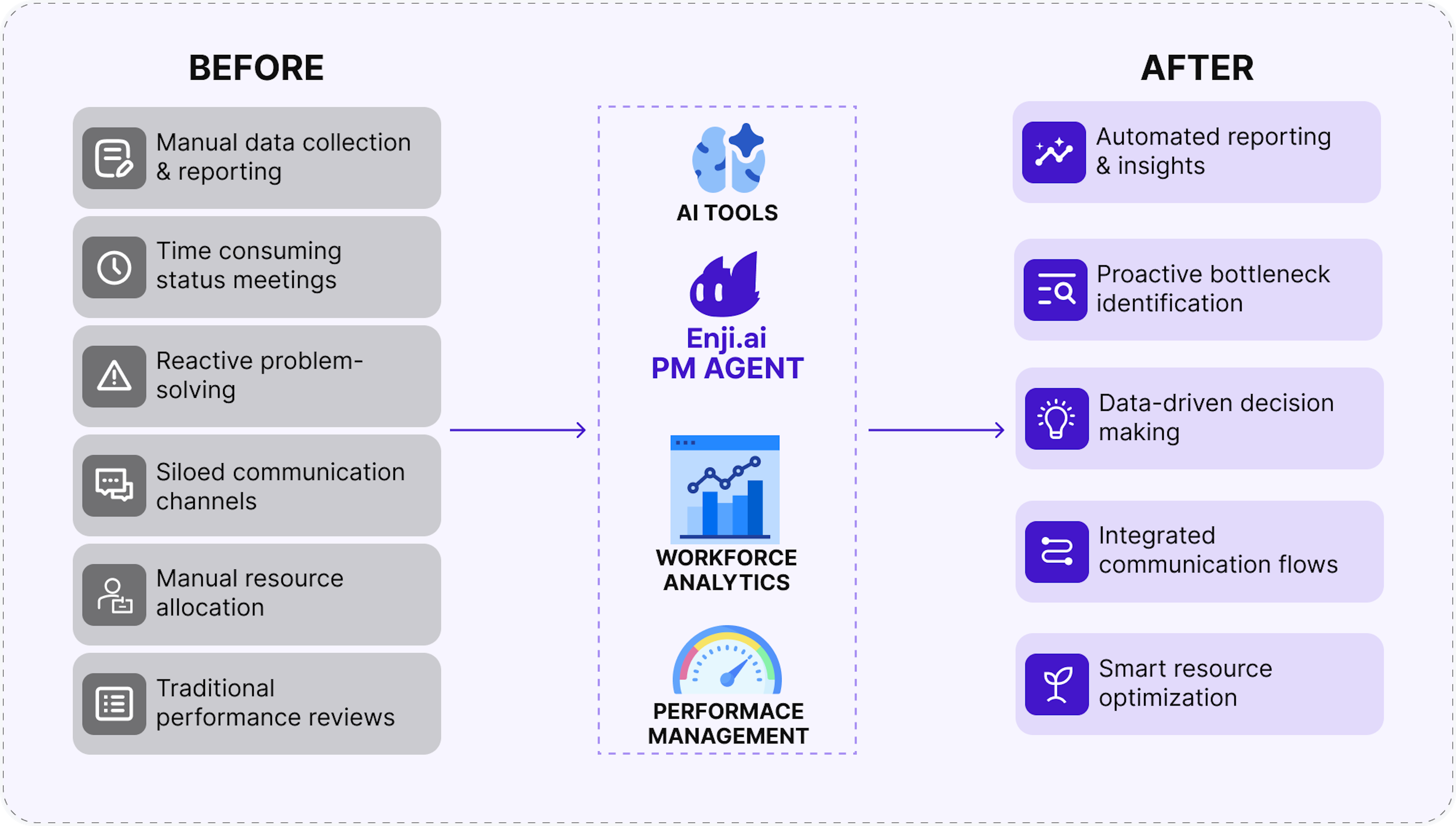Resource Management Glossary: Key Terms
Definition of Workforce efficiency
What is workforce efficiency?
Workforce efficiency represents an organization's capacity to maximize productivity and output of its employees while minimizing wasted time, effort, and resources. It's not about working harder—it's about working smarter through systematic approaches that enable teams to accomplish more meaningful work with less friction.
Organizations with high workflow efficiency consistently deliver quality outcomes within established timeframes, adapt swiftly to changing conditions, and maintain sustainable operational costs. This creates a reinforcing cycle where success breeds further success, establishing sustainable competitive advantage through enhanced profitability, improved customer satisfaction, and higher employee engagement.
Why does workforce efficiency matter?
The business case for investing in workforce efficiency spans multiple performance dimensions:
- Reduces operational costs by eliminating unnecessary steps, redundant processes, and resource waste, directly improving profit margins and budget allocation
- Improves customer satisfaction through faster delivery times, more reliable service quality, and consistent project outcomes, leading to higher retention rates and referrals
- Boosts employee morale by streamlining workflows and reducing daily frustrations, which decreases staff turnover, lowers recruitment costs, and increases overall employee productivity
- Enhances competitiveness by enabling organizations to deliver superior results with fewer resources, allowing for more competitive pricing and faster market response
- Supports long-term growth by freeing up capital, time, and human resources that can be reinvested in innovation, new market opportunities, and strategic initiatives
In summary, workforce efficiency is crucial because it directly impacts an organization's bottom line by reducing operational costs, enhancing customer satisfaction, and increasing employee productivity while decreasing turnover. This enables companies to deliver better results with fewer resources, creating a competitive advantage that supports sustainable growth and profitability.
What are workforce efficiency metrics?
Measuring workforce efficiency requires clear, actionable metrics. These help leaders understand how well their teams are performing and where improvements are needed. Here are some of the most widely used workforce efficiency indicators:
- Employee productivity rate: Total output produced divided by the number of employees. Indicates individual contribution to organizational results.
- Task completion rate: Percentage of assigned tasks completed on time. Highlights workflow efficiency and potential bottlenecks.
- Utilization rate: Percentage of available time spent on productive work. Reveals effectiveness versus time lost to distractions.
- Revenue per employee: Total revenue divided by employee count. High values signal efficient human resource utilization.
- Absenteeism rate: Percentage of workdays missed due to unplanned absences. High rates often indicate engagement issues.
- Schedule adherence: How closely employees follow assigned schedules. Critical for roles requiring coordination.
- Quality of work ratings: Measures work standards to ensure efficiency doesn't compromise quality.
Regular tracking enables trend identification and data-driven decisions for continuous improvement.
How to improve workforce efficiency? 6 proven strategies
Boosting workforce efficiency is a continuous effort that requires more than broad initiatives—it’s about making intentional, practical changes that drive measurable results. Here are six focused strategies to help your teams work smarter:
- Map and eliminate workflow bottlenecks
Regularly review your team’s processes to identify where delays or redundancies occur. By addressing these specific pain points, you can streamline operations and free up valuable time for higher-impact work. - Set priorities based on business value
Instead of tackling every task as it comes, evaluate which activities directly support your organization’s core objectives. Focusing on high-value work ensures resources are used where they matter most. - Promote transparent, two-way communication
Encourage open dialogue about goals, challenges, and progress. When teams share feedback and updates regularly, it’s easier to align efforts and quickly resolve misunderstandings or obstacles. - Invest in skill development tied to business needs
Offer targeted training that addresses current skill gaps and prepares employees for evolving project demands. This approach increases flexibility and reduces downtime caused by knowledge shortages. - Monitor and adopt relevant technological innovations
Stay informed about new tools—especially AI-driven solutions—that can automate routine tasks, consolidate workflows, or provide actionable insights. Focus on technologies that integrate well with your existing systems and genuinely enhance productivity, rather than adding complexity. - Prioritize employee well-being as a productivity driver
Recognize that sustainable efficiency depends on a healthy, motivated workforce. Encourage regular breaks, manageable workloads, and celebrate efficiency improvements to keep morale high and burnout low.
By applying these targeted strategies, organizations can achieve meaningful improvements in workforce efficiency, ensuring that teams remain agile, focused, and ready to deliver their best work.
What AI tools can be used for workforce efficiency?
AI-powered tools are transforming workforce efficiency by automating routine tasks, providing actionable insights, and enabling smarter decision-making. Here's a curated list of leading AI solutions:
1. Enji PM Agent
Enji's Project Management Agent automates routine PM tasks, delivers real-time team insights, and generates custom reports. Managers can instantly identify bottlenecks, optimize workflows, and make data-driven decisions, reducing manual work by up to 90% and unlocking new strategies for performance improvement.
2. Visier
An advanced people analytics platform that aggregates workforce data, tracks productivity trends, and predicts future needs. Helps HR and business leaders make informed decisions about talent management and efficiency.
3. Lattice
AI-driven performance management tool for continuous feedback, goal tracking, and real-time analytics. Supports alignment between individual performance and strategic objectives, driving higher efficiency.
Key Takeaways
- Workforce efficiency means maximizing output while minimizing wasted time, effort, and resources.
- Key metrics include employee productivity rate, task completion rate, utilization rate, revenue per employee, and schedule adherence.
- Improving efficiency requires streamlined processes, clear priorities, open communication, ongoing training, and the right technology.
- AI tools like Enji PM Agent, Visier, Lattice, BambooHR, and Wrike automate routine tasks, provide actionable insights, and support smarter decision-making.
- Investing in workforce efficiency drives profitability, boosts morale, and positions organizations for long-term success.
Last updated in July 2025

